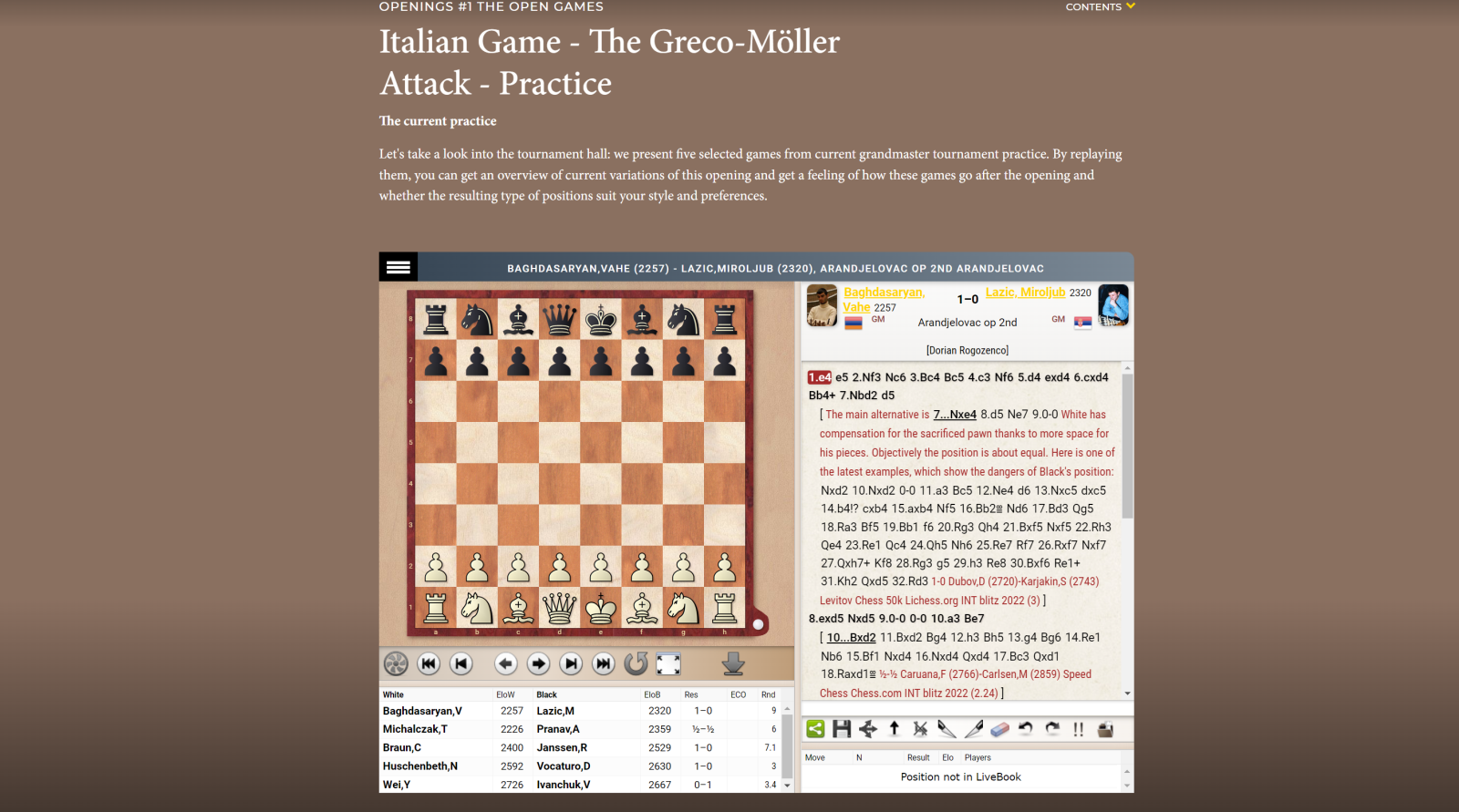


The essential plans and ideas are presented for all openings in the "Open Games" section (1.e4 e5). In 23 compact videos, top grandmasters show the essence of what is at stake.

FM Valeri Lilov demonstrating the plans, and ideas of 4.c3
There are actual master games to replay, and tactical exercises and typical traps for each opening.
 Countless master games with annotations are available to analyse
Countless master games with annotations are available to analyse
At the conclusion, you will discover for which type of player we particularly recommend each opening! The ChessBase opening tutorial gives you all the information you need to make a considered and well-founded opening choice!
 Learn about the open games 1. e4 e5 from wherever you are, on your iPad, or Macbook.
Learn about the open games 1. e4 e5 from wherever you are, on your iPad, or Macbook.
Opening training with ChessBase Books:
Video tutorials for all openings:
Everything you need to know:

The updated new edition in the new web-based ChessBase-books format. Whether iPad, PC, notebook, or smartphone: you only need the Internet for full access!
 Interview with the editor of the opening tutorial, Martin Fischer:
Interview with the editor of the opening tutorial, Martin Fischer:Martin, you are responsible for the new edition of the opening tutorial. What has changed compared to the old edition?
Firstly, the new format. The opening tutorial is published in the new ChessBase Books format. Thanks to the new format, we have more opportunities to present the respective opening system. With the current digital format of the ChessBase Books, we have more space available.
For each of the 22 systems we present, there is an introduction and then four sub-chapters. In the overview there is a video in which a grandmaster explains the essential ideas and manoeuvres of the opening system. This is followed by a section with five actual grandmaster games. This gives you an impression of how the opening works. The following section contains at least four more games with interactive training exercises for each opening. And in the final section there is an assessment of the type of player the opening in question suits and the amount of work required to learn this opening.
Do club players need this tutorial? Surely most of them have an overview and are not looking for new openings?
With my 50 years of experience in club and tournament chess, I believe that players who have an opening repertoire that suits them are the exception rather than the rule. It's often the case that they play the latest fashionable variations because they've seen one or two good games with them and want to win in the same way. Or you play an opening that can be played with as little theoretical knowledge as possible. Or you play the opening system that you have always played because you learnt it as a youngster. Rarely is an opening system consciously chosen according to where one's strengths and weaknesses lie. This is where the opening tutorial helps. The compact presentation of the opening systems quickly gives you a good impression of plans and motives, and - with our recommendations - you can check whether the position types suit you.
The openings are presented very compactly. Can you try out an opening with this knowledge?
Definitely yes! The knowledge imparted by the videos, but also by the sample games, is sufficient for an initial practical test.
Some of the videos are from the 1st edition, only Elisabeth Pähtz has re-recorded her videos. Why?
All the videos in the previous edition were of excellent quality. Particularly because the aim here was to present the main ideas, plans and manoeuvres for both sides. There was therefore no need to make any corrections here. This also applies to Elisabeth Pähtz's videos. However, her presentation style has changed so much in recent years that it seemed appropriate to re-record the videos.
Did you yourself feel like trying out a different opening while working on the tutorial? Did something arouse your interest?
I myself have been playing 1. e4 exclusively for some time now. In this respect, the work has helped me to become much more confident with some systems than was previously the case. Apart from that, I can now imagine opening games with the Ruy Lopez again.
You are a strong club player, but not a grandmaster. Were there any difficulties in evaluating the openings because of this? How did you deal with this?
When assessing the openings, I was able to draw on my many years of experience as a tournament and club player. And I belong to the target group of the opening tutorials, so my impression was a good starting point for an assessment. I could also rely on Grandmaster Dorian Rogozenco as the highest authority to check all my assessments and correct me if necessary. As a result, we arrived at serious assessments.
Keyword target group. Who is it for? What benefits does the opening tutorial have for beginners, club players and players?
The tutorials offer every user the opportunity to gain essential and basic knowledge of every opening system covered. This also includes an assessment of the type of player the resulting positions suit and the amount of work required to be able to play the opening safely. The opening tutorial enables every chess player to check whether a particular opening suits them. And also to test the opening first. In short: the opening tutorial helps you to find the right opening for you.
| Advertising |